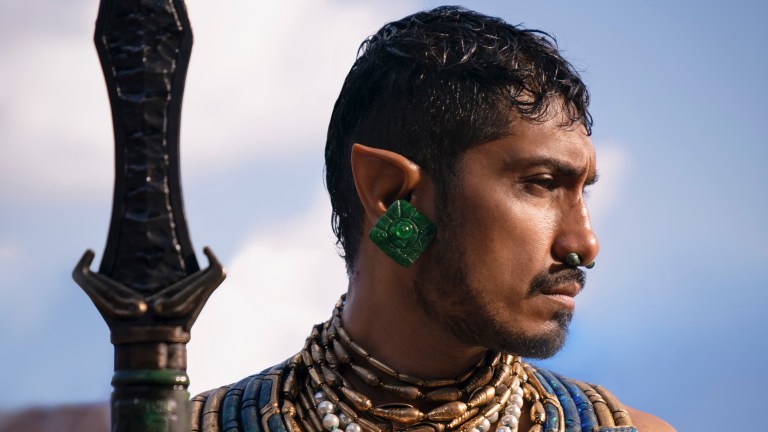Black Panther’s Namor Marks a Major Moment in Marvel History
Marvel brings one of its very first characters the screen at last in Black Panther: Wakanda Forever.

Before Spider-Man, before Iron Man and the Fantastic Four—before even Captain America—there was one major super-being in the Marvel pantheon. Along with the Human Torch, he was among the first characters ever created by the company, existing even before the company was called Marvel Comics. His name is Namor, also known as the Sub-Mariner, and he first appeared in Marvel Comics #1, published in late August 1939 by Marvel predecessor Timely Publications. While that book’s Human Torch is not the Fantastic Four member we all know and love today, Namor has remained largely the same over the intervening decades.
Half-human, half-Atlantean (in the comics), and one of the earliest examples of the evolved human beings that came to be called “mutants” in Marvel canon, he was the fierce ruler and protector of the undersea kingdom of Atlantis with a healthy distaste for the surface world. An anti-hero in the classic sense, he nonetheless teamed over the years with the Avengers, the Illuminati, the Fantastic Four, the X-Men, and other Marvel heroes to defend the planet from menaces both Earthbound and interstellar.
With a storied history in the pages of Marvel Comics, it has been natural to wonder for years when Namor would make his live-action debut in the Marvel Cinematic Universe. Now that dream has come true in the form of actor Tenoch Huerta Mejia, who plays a reconfigured version of the Sub-Mariner (and is not actually called that) in Black Panther: Wakanda Forever.
Various screen versions of Namor had been optioned as early as 1997 (via Variety), long before there was a Marvel Studios or MCU, and as a result it took years for the latter to actually regain the rights to the character. Once he was in the MCU fold, however, it became simply a matter of figuring out the right time to bring Namor into the franchise, as Wakanda Forever producer Nate Moore tells Den of Geek.
“It’s like jump rope,” Moore explains. “You’re trying to jump in there. When’s the right time? You want to make sure, especially when it’s a character of this importance, that they’re given an actual moment, and it doesn’t feel like they’re introduced with a bunch of other ideas… He’s not a character that you can pop in with a bunch of other people. He demands more story because he’s so interesting.”
The producer adds that introducing Namor into the world of Wakanda was an idea hatched by Black Panther director Ryan Coogler, even as post-production on that film was in its final stages: “[Coogler said], ‘We’ve got to figure out how to put these two great civilizations at odds with each other.’”
Even as Coogler, co-writer Joe Robert Cole, and the Marvel brain trust had to pivot to a different storyline for Wakanda Forever in the wake of the shocking, tragic passing of Chadwick Boseman, Namor remained an integral part of the narrative all along.
But while Coogler wanted to incorporate classic elements of the character, such as his ankle wings and ability to fly, he also saw an opportunity to reconfigure the Sub-Mariner’s origin story.
“We were constantly negotiating what makes Namor Namor,” Coogler says. “But also, how does he work for the film that we’re trying to do? He had to be the right antagonist for this movie. He had to feel like he belonged in this world that we built on the previous film. So it took a lot of work, a lot of thought. Everything was intentional, but we were really happy with where we landed.”
In the new interpretation of the character, Atlantis (which is also a component of the DC film and comics universe via the story of Aquaman) has become Talokan, an undersea civilization founded by people of Mayan descent who are forced to flee colonial oppressors and whose physiology is altered by natural elements that allow them to breathe, live, and thrive underwater.
“The idea of a sunken island or continent, or lost people in the ocean, the most famous concept that we know of in our culture is Plato’s Atlantis,” explains Coogler. “There’s been several depictions of that. I kind of took that Greco-Roman approach and built out from there.”
Coogler, production designer Hannah Beachler, and costume designer Ruth Carter set about creating a civilization that could credibly look like it exists under the ocean while keeping it “grounded” in the sense of the Talokanil (citizens of Talokan) feeling like a real society.
“We wanted to make something that was both specific to the story that we were trying to tell and the themes and the concepts that we explored in the first one,” Coogler continues. “As we researched it, we found that a lot of cultures had this concept of an island that was lost somewhere, or a continent that sunk, or a group of people that lived beneath where they were from.”
Much like Wakanda was based on real cultures on the African continent, Coogler says that it made sense to reimagine Talokan as an offshoot of South America, with a similar history making Wakanda and Talokan almost reflections of each other.
“It made a lot of sense when you look at history,” Coogler says “The colonization, exploitation, culture-shifting that happened on the continent of Africa in terms of when they came in contact with the Western world, a lot of similar things happened in the Americas right here. Once we unlocked that type of thinking, it made sense. It was all kind of downhill from there.”
The result is a version of Namor that embraces and is respectful of the character’s 80-plus-year history, while updating him to fit the world of the MCU and the story of both Wakanda and Talokan’s places in it. “It had to be a movie where we could really embrace Namor and really look at his world,” says Nate Moore. “And really deliver on the scale that needed to be told.”
Black Panther: Wakanda Forever is out in theaters this Friday, Nov. 11.
